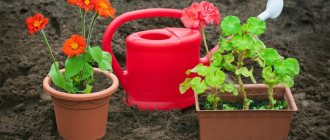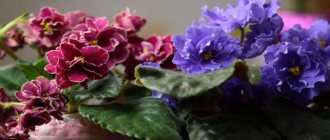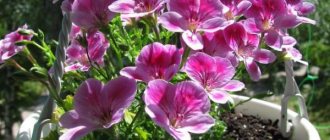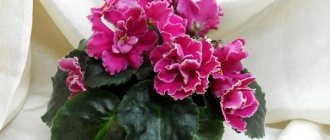Description of appearance
Rosebud geranium is a perennial that belongs to the Geranium family. It is distinguished by a branched rhizome. It has a herbaceous and tough stem, which over time becomes woody at the bottom. The leaves are lobed, the cutouts on the leaf blade do not exceed 1/3 of the half-width. The fruits of the plant are box-shaped.
Attention : Geranium is propagated by seeds and cuttings. The plant has a positive attitude towards abundant watering and loves warmth.
Difference from tulip-shaped
Very often these two types of plants are confused with each other. But rosebud geranium is distinguished by more lush and double flowers, reminiscent of roses and collected in large inflorescences.
Popular pink varieties and photos with them
Let's consider varieties of beautiful rosebud geranium. Also in the photo you can see blooming rosaceous plants, for example, Rosita with bright pink flowers, or Terry with amazing crimson roses and other varieties of geranium.
Apple Blossom Rosebud
This plant forms small perennial bushes with large and lush apical inflorescences. The umbrellas are dense, obtained from densely double buds. The only drawback of the culture is its tendency to grow rapidly , as a result of which it is necessary to regularly prune.
Tulip-shaped
This is a miniature bush in which all the inflorescences are collected together. They have a dark pink color. Caring for the crop is not difficult, which is why the variety is so valued by gardeners. You can learn about tulip-shaped geraniums, cultivation characteristics and varieties of this type of flower here.
Red
This is a miniature plant that does not grow much. The apical shoots are burgundy in color, and chaotic strokes are scattered across the petals of the flower . The disadvantage of this variety is that it is difficult to get side shoots, so it is not always possible to form a bush.
Terry
This is another amazing variety of rosebud geranium, whose buds take on crimson, purple and coral colors. They bloom like umbrellas.
Rosita
This variety fascinates with its beautiful flowers. Their shape is reminiscent of buttercups, but they have a terry structure and a bright pink color. The plant develops slowly, but flowering lasts a long time - for 2 weeks.
Description of the plant and its varieties
The right choice begins with introduction and description.
The appearance of the plant depends on its ownership:
Zonal. The leaves are round and wavy at the edges. Along the perimeter of the dark green leaf there is a purple or red-brown rim. Varieties with leaves of unusual color have been bred:
- Black
- Bronze
- Golden
- Violet
Pelargonium - photo of flowers
The bush grows from 10 to 60 cm in height and has a compact shape, provided it is formed in a timely manner and has good lighting.
With a lack of light, the plant stretches and loses its attractiveness.
Ivy leaf. The name speaks for itself. The leaves are rich green in color and cut into ivy shapes.
The inflorescences are located on peduncles that can reach up to 80 cm. Plants with such data are considered ampelous and are planted in hanging pots and baskets.
There are several popular varieties:
Apple Blossom Rosebud. The very first variety of pelargonium with pink flowers. Many small roses with pink petals at the edges and white petals in the center are gathered densely in one ball. They are arranged so that each flower can be viewed separately.
In the very center of the half-opened flower there is a light green spot. The height of an adult bush is from 30 to 50 cm. It blooms profusely and for a long time, subject to regular feeding.
Pelargonium Bornholm. The bright scarlet flowers in the caps of the inflorescences resemble tea roses in miniature. They rise on peduncles above lush green leaves. Each of them has a pattern of golden veins. It appears only on adult bushes. The height of the plant including flowers is about 40 cm.
Pink Rambler. Each of its flowers resembles a two-color Nostalgie rose with its red and white petals. The bush is compact, no more than 40 cm high. The leaves of roseate geranium are bright green with pale zonal rings.
Geranium - photo of flowers
Pelargonium Sister Henry. The bush is dense with regular green foliage, about 30 cm high. It blooms profusely throughout the summer with pink flowers collected in loose balls. Each of the rose geranium buds opens almost completely.
PAC Viva Carolina. This is a variety of ivy-leaved pelargonium. It features delicate pink and white flowers. Each of them is a small English rose with a special flower structure.
All this beauty, set against a backdrop of shiny green ivy leaves, adorns hanging baskets throughout the summer.
The plant easily produces side shoots. If you pinch them in time after the second leaf, the bush will be more luxuriant. Fertilizing will increase the number of inflorescences.
Lovers of rosaceous geraniums strive to collect the entire collection. And beginning flower growers can limit themselves to two varieties of contrasting shades. This will allow you to form an opinion about the plant.
Expert opinion
Yulia Yurievna
I have a large garden and vegetable garden, several greenhouses. I love modern methods of cultivating plants and mulching the soil, and I share my experience.
Ask a Question
Geranium with roses is a spectacular and unpretentious plant. We would like to note that double geranium can also look very decorative, although its buds are not so similar to roses. Terry geranium grows in the form of a compact bush. With proper care, these flowers can produce buds almost all year round. Red geranium of the Silk fun variety is distinguished by the scarlet color of its buds. A characteristic feature is a light spot in the middle of the flower. Sometimes the said plant has raspberry buds. Pelargonium terry Ludwigsburger Flair has flowers with many petals. The buds are pink and white. Sometimes the lightest parts of the petals have greenish inclusions. This variety is considered dwarf. At the same time, the inflorescences are distinguished by their large size and beautiful flowering. Terry geranium Silk lagoon is a miniature plant that pleases the gardener with large buds of peach-coral color. The petals seem to be gathered into folds. Because of this, the buds seem even more magnificent. Pelargonium blooming variety Silk Swan slightly resembles rosebuds with its inflorescences. The bushes are small, but the stems are quite wide. The buds are large, with smooth petals. The color is white, sometimes the buds have a purple, lilac or pink tint. There is a culture called Pelargonium Yu Wild Rose. This is a very beautiful plant with lilac-pink buds. This rose geranium is a double species. Cultivated indoors and also in the garden. Can grow on the balcony. The bush is compact.
Where and how to plant it?
It is better to replant the plant in March. To do this, you need to prepare a spacious plastic container. Lay a layer of drainage and fill 1/3 of the container with nutritious soil purchased at the store.
After the preparatory work, replant the plant using the transshipment method, distribute the roots and add soil, compact it and water it.
Lighting and location
To grow rosebud geranium, you need a well-lit room in which there will be no direct sunlight. But a room that is too dark and shaded is not suitable, because geranium is a light-loving crop. It is important to monitor the room temperature, which should be 17-23 degrees Celsius.
Soil requirements
Rosebud geranium prefers to grow in loose, moist and nutritious soil. It should be well breathable and have a neutral pH level.
You can buy soil in a specialized store or prepare it yourself . If you prepare it yourself, you will need to mix the following ingredients:
- turf soil - 4 parts;
- peat – 2 parts;
- sand – 1 part;
- perlite – 1 part;
- humus - 2 parts.
Features and care at home
A characteristic feature of zonal geranium is a colored border in the form of a dark spot along the edges of a round leaf.
May be dark green, dark brown or yellowish in color. In another way, the variety of colors on the leaves is called variegation.
The second important feature of geranium is its strong tart smell. Moreover, both flowers and foliage smell.
Advantages
Zonal geranium is one of the most unpretentious and hardy representatives of the plant world.
- Disinfects indoor air.
- The healing properties of essential oils are used in medicine in the treatment of insomnia, neuroses, hypertension and other diseases.
- Geranium essential oils are used in the cosmetic industry.
- Long and lush flowering from early spring to late autumn.
Flaws
Disadvantages include pests and diseases that enter through the soil or due to improper care.
Landing
Proper planting is the key to proper cultivation of crops both at home and outdoors. This beauty is planted as an ornament in flower beds, borders, on balcony boxes, for portable containers, for all types of flower beds and simply in large pots.
- The right choice of location is necessary. Geranium loves light, grows well and blooms when exposed to direct sunlight, especially in open ground; when shaded, the flowering is less lush.
- The soil composition should include humus, peat, leaf and turf soil. You can add sand for better moisture permeability. At the bottom of the pot, drainage from small pebbles or river pebbles is required.
- Properly selected container. You cannot plant in large pots, otherwise the geranium simply will not bloom. The roots should fill the entire space of the container. The size of the pot depends on the root ball of the plant, the diameter should not be more than 15 cm, the height should not exceed 12 cm.
- Landing technique. It is carried out in a transshipment manner together with a lump of earth on the roots for less trauma to the plant. Then you need to water. When planting seedlings, the distance between the bushes should be about 25 cm.
They are planted in open ground after May 15, when the threat of frost has passed. You can take it out onto balconies earlier.
Watering
Water should be abundant, but not excessive. When overmoistened, the roots begin to rot and the geranium may die, especially in winter. The soil should dry out between waterings. When planting outdoors, constant watering is only necessary for young plants or during long dry weather.
Fertilizer
For rapid growth of green mass and awakening of buds after winter, nitrogen fertilizer is necessary. Starting in April, fertilizing with phosphorus-potassium fertilizer is required for favorable flowering of zonal geranium. In winter, fertilizing is not used. In flowerbeds, plants are fertilized every 10-12 days until mid-August, and on balconies once a week.
Trimming
Zonal geranium is pruned twice a year. For the first time after winter, with the appearance of the first rays of sunlight, shoots are cut to further stimulate flowering, leaving 2 to 5 buds. The main pruning is autumn, necessary for better bushiness, carried out in late September-early October. In the fall, cut out old, unnecessary shoots and pinch out the apical buds.
Trimming can only be done to ⅓ or ⅔ of the height of the geranium. Pruning should only be done with a sharp, disinfected blade at an angle. The cut area is sprinkled with coal.
Reproduction
There are two ways to propagate zonal geranium:
- Vegetative—cuttings and leaves.
- Seeds.
Cuttings
It is the easiest and fastest way to reproduce. After spring-autumn pruning, you need to leave strong, strong cuttings without flowers, 10-15 cm in size, without uneven ends of the stem with two or three leaves.
- First, the cut must be dried a little, then placed in water until a thickening is obtained at the end of the stem.
- Rooting occurs quickly, this process takes 5-10 days, after which we transplant it into the ground into a small-diameter pot with drainage, water it as needed, and protect the young sprout from the bright sun.
You can also root the cuttings in a peat tablet without watering until the geranium takes root.
Propagation by seeds
- It is advisable to lightly rub the seeds with sandpaper for better germination.
- Soak for 3 hours in any growth stimulator, then in plain water for several hours.
- Sow in a container with moistened special soil for geranium plants; drainage must be placed at the bottom. You can plant with a toothpick at a distance of 5 cm from each other, without digging too much.
- The container is covered with film and placed in a warm, well-lit place at a temperature of 20-22 degrees.
- Shoots appear after two weeks, after which the temperature can be slightly lowered.
- Seedlings are picked after 3-4 leaves appear.
Home care
Humidity and watering
The plant does not have any special requirements for humidity, but it is important to maintain it within 60-70%. To do this, the room must be regularly ventilated.
Frequent moistening is unacceptable for geraniums, as this causes them to rot . It is necessary to moisten the soil as needed. Also check it regularly for moisture. If there is liquid, then there is no need to water the plant. When the soil crumbles and leaves no traces on your hands, it is simply necessary to irrigate it.
Do not use hot or too cold water for irrigation. It is better to use liquid that has settled in advance.
Tip : Geranium should be sprayed with a spray bottle every week. Wipe the leaves and stem with a damp cloth.
Feeding
It is recommended to use fertilizers before and during flowering . In spring, mineral fertilizers are used. They are used once every 2-3 weeks, and the dosage is calculated individually. As soon as the buds begin to form, add phosphorus-potassium compounds to the fertilizing. At the beginning of autumn, additional drugs are eliminated so that the plant can prepare for winter.
Trimming
The plant should be pruned after it has flowered. First, you need to inspect the flower and remove those parts that need to be fixed. If the stems are too long, remove them. If it is necessary for new shoots to form, then pruning should be done above the node.
In autumn, the stems need to be cut back by 1/3 . But since the flower continues to grow in winter, after the formation of the 5th bud, the bush needs to be pinched.
Common diseases and pests
When growing rosebud geranium, the following problems are possible:
The leaves are withering . This is a signal that the room is too warm or the plant is standing near the radiator. To save the flower, you need to increase the humidity and increase the air humidity.- The leaves have changed color . This indicates too much watering or not enough light.
- Spots on leaves . They indicate a viral infection. To save the flower, it must be transplanted into another soil and the plant treated with fungicides. Also conduct an inspection for parasites. In any case, it does not interfere with treatment with an aspirin solution (1.25 per 10 liters of water).
- The flowers are drying up . This is a symptom of fungus. To combat it, you need to treat the plant with Bordeaux mixture 5% or phytosporin.
- Whitefly and aphids. Fitoverim is used for processing. Be sure to treat the plant that is located nearby.
- Gray rot . This is the most dangerous enemy. The disease can be recognized by the presence of brown spots on the leaves of the flower. It is characterized by rapid spread. Treatment must be comprehensive. For these purposes, fungicides are used, nitrogen-containing fertilizers are excluded, watering and spraying are reduced, and soil looseness is monitored. In addition, the room should be well lit.
- The plant is withering . This is the result of fungal activity. The disease can be recognized by the presence of yellow and wilting lower leaves. If no action is taken, yellowness will begin to affect the remaining leaves. Trichodermin is used for treatment. You also need to change the soil mixture, as some fungi can remain viable in the soil for 15 years.
Transplantation and watering regime
Complex formulations for indoor plants are used as fertilizers. Nitrogen-containing fertilizers can be fed only to decorative deciduous, non-flowering specimens. During the period when budding begins, focus on adding phosphorus and calcium - they will activate dormant flower buds and the plant will bloom even more magnificently.
Transplantation of terry pelargonium occurs in the same way as with other varieties. Please note that the pot should not be much larger (about the thickness of a finger), otherwise the plant will not bloom until the roots occupy all the free space in the pot.
For the normal development of pelargonium, a special watering regime is needed. The soil should not become too waterlogged, so the pots should be equipped with strong drainage holes. Moisture should not stagnate in the pan, from where it must be removed immediately after watering. It is best to water the perennial with warm melt water (room temperature, if you keep the plant at home). Avoid differences in air and soil temperatures - this can cause rotting of the root system and death of pelargonium. Also, therefore, choose a container for planting made of clay or wood; such materials react less than others to changes in air temperature.
Pelargonium is watered approximately once every 2-3 days. During the warm season, try to maintain high air humidity. In winter, protect the plant from the dry flow that comes from heating partings. If placement near a radiator is unavoidable, insulate the plant from the heat with a glass screen.
Features of reproduction
To propagate rosebud geranium, the seed method and cuttings are used.
Seminal
- Wrap the planting material in damp gauze. Leave it for 7-10 days in a room where there is no dry air. During this time, monitor the moisture content of the fabric.
- When the seeds swell, transplant them into the prepared substrate. Cover the container with polyethylene and water the soil regularly.
- As soon as a sprout appears and 4 leaves grow on it, the film can be removed and the plants can be planted in separate pots.
- The grown plant is placed in a container of suitable volume. It is better to use a clay pot, as this material allows air to pass through better. Drainage laid in a layer of 3 cm will prevent rotting of the root system.
Cuttings
Geranium cuttings can be carried out throughout the year , but the best time is from March to July. Procedure:
Cut a semi-lignified cutting from the mother plant, which will have 3-5 internodes, since the green and grassy one will not take root.- Use only purchased soil, adding vermiculite to it.
- Pour the nutrient mixture into transparent plastic cups and plant the prepared cuttings. Preparation of planting material includes cutting, removing leaves and air drying for 30-40 minutes.
- In the first days, water carefully so as not to overwater or overdry.
- Rooting of cuttings occurs under lamps for 2-3 weeks.
- As soon as the first roots form, you can add more fertile soil.
The familiar geranium, this unpretentious and incredibly beautiful flower, is famous for its most amazing variety of species and varieties. How to choose what to plant in the garden or on the windowsill? Our articles will help you navigate. From them you can learn about the perennial Peony and the annual Robert, about Rosanna, which blooms all summer, about hybrids of the Angel variety and the interesting Plenum geranium, read what is good about Max Fry, how to care for the fragrant Lemon and fragrant, how to grow black geranium.











